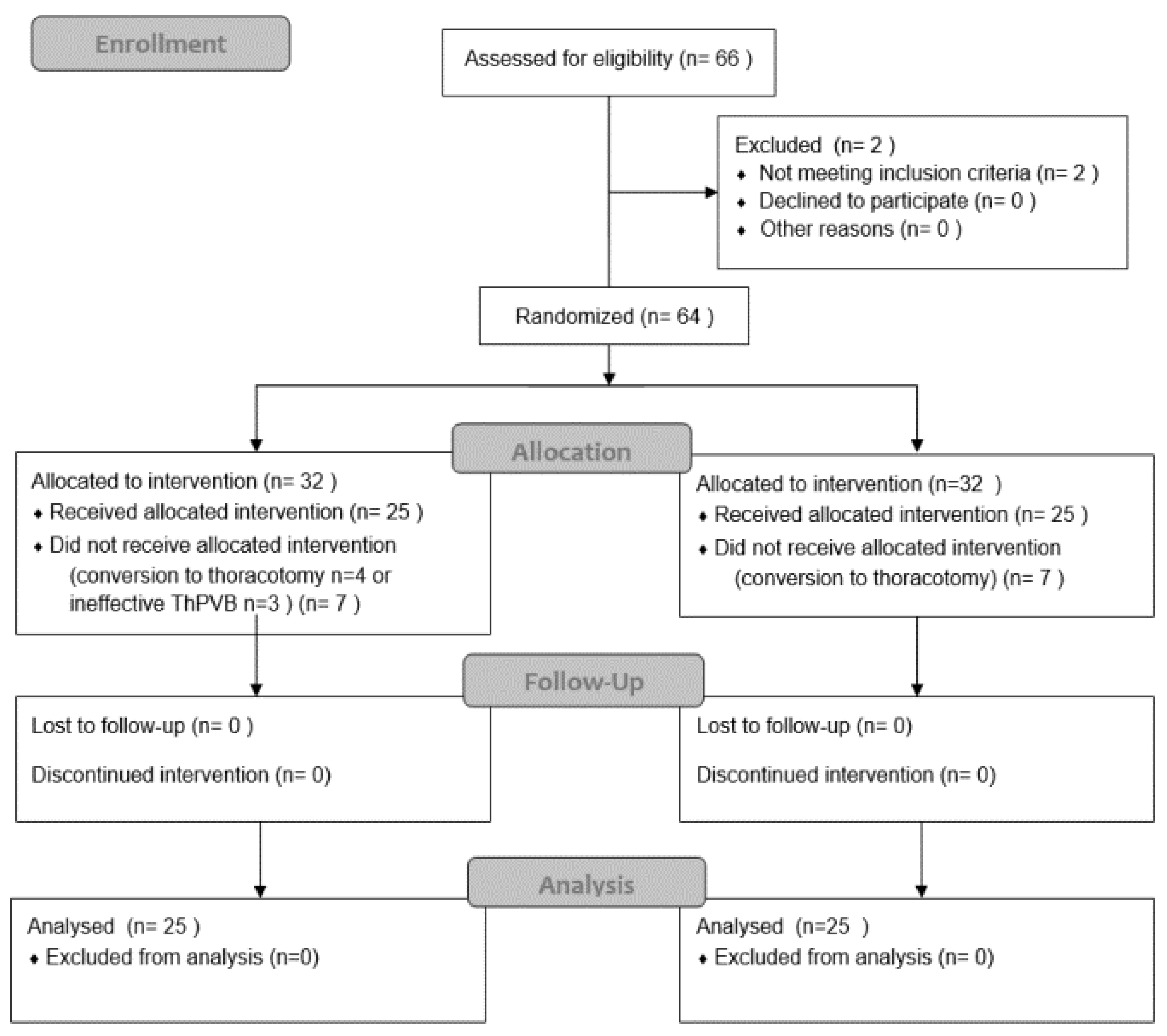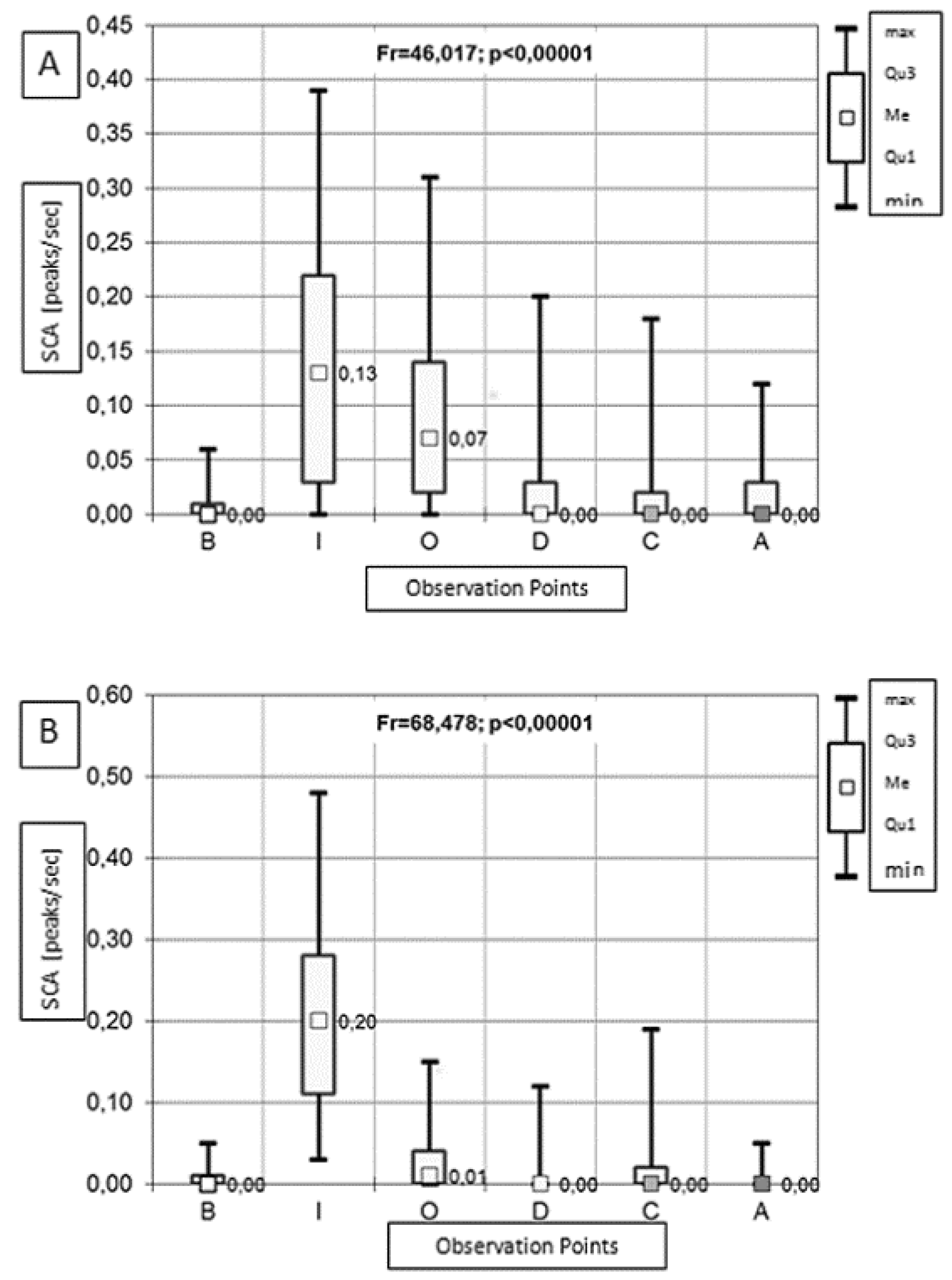Opioid-Free Anaesthesia Effectiveness in Thoracic Surgery—Objective Measurement with a Skin Conductance Algesimeter: A Randomized Controlled Trial
Abstract
1. Introduction
2. Materials and Methods
2.1. Protocol
- Typical general anaesthesia with opioids (control group);
- OFA and ThPVB (OFA group).
- Immediately after anaesthesia induction, lidocaine (Lidocaine hydrochloride WZF, Polfa Warszawa S.A., Poland) was administered as an i.v. bolus at a dose of 1.5 mg∙kg–1 and ketamine (Ketalar, Pfizer, Poland) in an i.v. bolus of 0.35 mg∙kg–1;
- This was followed by an infusion of lidocaine at 2.0 mg∙kg–1∙h–1 for 2 h, continued at a dose of 1.2 mg∙kg–1∙h–1, and ketamine infusion at 0.2 mg∙kg–1∙h–1 for 2 h, continued at a dose of 0.12 mg∙kg–1∙h–1.
2.2. Measurements
2.3. Statistical Analysis
3. Results
4. Discussion
5. Conclusions
6. Limitations
Author Contributions
Funding
Institutional Review Board Statement
Informed Consent Statement
Data Availability Statement
Conflicts of Interest
Abbreviations
| Abbreviations and Acronyms | |
| ASA | American Society of Anesthesiologists |
| BMI | Body Mass Index |
| DBP | Diastolic Blood Pressure |
| HR | Heart Rate |
| MBP | Mean Blood Pressure |
| OFA | Opioid-Free Anaesthesia |
| SCA | Skin Conductance Algesimeter |
| ThPVB | Thoracic Paravertebral Block |
| VATS | Video-Assisted Thoracic Surgery |
References
- Gottschalk, A.; Cohen, S.; Yang, S.; Ochroch, A.; Warltier, D. Preventing and Treating Pain After Thoracic Surgery. Anestshiology 2006, 104, 594–600. [Google Scholar] [CrossRef]
- Gotoda, Y.; Kambara, N.; Sakai, T.; Kishi, Y.; Kodama, K.; Koyama, T. The morbidity, time course and predictive factors for persistent post-thoracotomy pain. Eur. J. Pain 2001, 5, 89–96. [Google Scholar] [CrossRef]
- Gerner, P. Postthoracotomy pain management problems. Anesthesiol. Clin. 2008, 26, 355–367. [Google Scholar] [CrossRef]
- Bertrand, P.; Regnard, J.; Spaggiari, L.; Levi, J.F.; Magdeleinat, P.; Guibert, L.; Levasseur, P. Immediate and long-term results after surgical treatment of primary spontaneous pneumothorax by VATS. Ann. Thorac. Surg. 1996, 61, 1641–1645. [Google Scholar] [CrossRef]
- De la Gala, F.; Piñeiro, P.; Reyes, A.; Vara, E.; Olmedilla, L.; Cruz, P.; Garutti, I. Postoperative pulmonary complications, pulmonary and systemic inflammatory responses after lung resection surgery with prolonged one-lung ventilation. Randomized controlled trial comparing intravenous and inhalational anaesthesia. Br. J. Anaesth. 2017, 119, 655–663. [Google Scholar] [CrossRef]
- Mathiesen, O.; Thomsen, B.A.; Kitter, B.; Dahl, J.B.; Kehlet, H. Need for improved treatment of postoperative pain. Dan. Med. J. 2012, 59, A4401. [Google Scholar]
- Ochroch, J.; Usman, A.; Kiefer, J.; Pulton, D.; Shah, R.; Grosh, T.; Patel, S.; Vernick, W.; Gutsche, J.T.; Raiten, J. Reducing Opioid Use in Patients Undergoing Cardiac Surgery-Preoperative, Intraoperative, and Critical Care Strategies. J. Cardiothorac. Vasc. Anesth. 2021, 35, 2155–2165. [Google Scholar] [CrossRef]
- Allegri, M.; Grossi, P. Management of postoperative pain: How accurate and successful is our acute pain management? Minerva Anestesiol. 2012, 78, 1–3. [Google Scholar]
- Wallden, J.; Halliday, T.A.; Hultin, M.; Sundqvist, J. PONV in bariatric surgery: Time for opioid-free anaesthesia. Acta Anaesthesiol. Scand. 2017, 61, 858. [Google Scholar] [CrossRef]
- Gomez-Menendez, J.; Caballero-Lozada, F.; Barahona-Cabrera, F.; Urueta-Gaviria, V.; Zorrilla-Vaca, A. Erector spinae plane block for postoperative analgesia in thoracoscopic lobectomy in a paediatric patient. Anaesthesiol. Intensive Ther. 2019, 51, 171–172. [Google Scholar] [CrossRef]
- Aronsohn, J.; Orner, G.; Palleschi, G.; Gerasimov, M. Opioid-free total intravenous anaesthesia with ketamine as part of an enhanced recovery protocol for bariatric surgery patients with sleep disordered breathing. J. Clin. Anesth. 2019, 52, 65–66. [Google Scholar] [CrossRef]
- Manso, A.; Bustamante-Domínguez, C.; Escalona-Belmonte, J.J.; Cruz-Mañas, J.; Guerrero-Orriach, J.L. Laparotomy in a patient under opioid free anesthesia. An. Sist. Sanit. Navar. 2018, 41, 259–262. [Google Scholar]
- Ghee, C.; Fortes, D.; Liu, C.; Khandhar, S. A Randomized Controlled Trial of Continuous Subpleural Bupivacaine After Thoracoscopic Surgery. Semin. Thorac. Cardiovasc. Surg. 2018, 30, 240–249. [Google Scholar] [CrossRef]
- Van de Ven, T.; John Hsia, H. Causes and prevention of chronic postsurgical pain. Curr. Opin. Crit. Care 2012, 18, 366–371. [Google Scholar] [CrossRef]
- Katz, J.; Jackson, M.; Kavanagh, B.; Sandler, A. Acute pain after thoracic surgery predicts long-term post-thoracotomy pain. Clin. J. Pain 1996, 12, 50–55. [Google Scholar] [CrossRef]
- Hansen, J.; Storm, H.; Boglino-Hörlin, A.; Le Guen, M.; Gayat, E.; Fischler, M. Skin conductance as a pain assessment tool during chest tube removal: An observational study. Eur. J. Pain 2017, 21, 987–996. [Google Scholar] [CrossRef]
- Julien-Marsollier, F.; Rachdi, K.; Caballero, M.-J.; Ayanmanesh, F.; Vacher, T.; Horlin, A.-L.; Skhiri, A.; Brasher, C.; Michelet, D.; Dahmani, S. Evaluation of the analgesia nociception index for monitoring intraoperative analgesia in children. Br. J. Anaesth. 2018, 121, 462–468. [Google Scholar] [CrossRef]
- Chanques, G.; Tarri, T.; Ride, A.; Prades, A.; De Jong, A.; Carr, J.; Molinari, N.; Jaber, S. Analgesia nociception index for the assessment of pain in critically ill patients: A diagnostic accuracy study. Br. J. Anaesth. 2017, 119, 812–820. [Google Scholar] [CrossRef]
- Ledowski, T. Objective monitoring of nociception: A review of current commercial solutions. Br. J. Anaesth. 2019, 123, e312–e321. [Google Scholar] [CrossRef]
- Gjerstad, A.; Wagner, K.; Henrichsen, T.; Storm, H. Skin conductance versus the modified COMFORT sedation score as a measure of discomfort in artificially ventilated children. Pediatrics 2008, 122, e848–e853. [Google Scholar] [CrossRef]
- Six, S.; Laureys, S.; Poelaert, J.; Bilsen, J.; Theuns, P.; Musch, L.; Deschepper, R. Should we include monitors to improve assessment of awareness and pain in unconscious palliatively sedated patients? A case report. Palliat. Med. 2019, 33, 712–716. [Google Scholar] [CrossRef]
- Six, S.; Laureys, S.; Poelaert, J.; Bilsen, J.; Theuns, P.; Deschepper, R. Comfort in palliative sedation (Compas): A transdisciplinary mixed method study protocol for linking objective assessments to subjective experiences. BMC Palliat. Care 2018, 17, 62. [Google Scholar] [CrossRef]
- Passariello, A.; Montaldo, P.; Palma, M.; Cirillo, M.; Di Guida, C.; Esposito, S.; Caruso, M.; Pugliese, M.; Giliberti, P. Neonatal painful stimuli: Skin conductance algesimeter index to measure efficacy 24% of sucrose oral solution. J. Matern. Fetal Neonatal Med. 2019, 20, 3596–3601. [Google Scholar] [CrossRef]
- Karpe, J.; Misiołek, A.; Daszkiewicz, A.; Misiolek, H. Objective assessment of pain-related stress in mechanically ventilated newborns based on skin conductance fluctuations. Anaesthesiol. Intensive Ther. 2013, 45, 134–137. [Google Scholar] [CrossRef]
- Khanna, P.; Chandralekha, C.; Pandey, R.; Sharma, A. Pain assessment in the critically ill mechanically ventilated adult patients: Comparison between skin conductance algesimeter index and physiologic indicators. Saudi J. Anaesth. 2018, 12, 204–208. [Google Scholar]
- Paleczny, J.; Łoniewska-Paleczny, E.; Pysz, M.; Hura, G. Thoracic paravertebral block versus general anaesthesia in breast surgery. Anaesthesiol. Intensive Ther. 2005, 1, 12–16. [Google Scholar]
- Lohser, J.; Slinger, P. Lung injury after one-lung ventilation: A review of the pathophysiologic mechanisms affecting the ventilated and the collapsed lung. Anesth. Analg. 2015, 121, 302–318. [Google Scholar] [CrossRef]
- Vozoris, N.; Pequeno, P.; Li, P.; Austin, P.; O’Donnell, D.; Gershon, A. Predictors of Opioid-related Adverse Pulmonary Events among Older Adults with Chronic Obstructive Pulmonary Disease. Ann. Am. Thorac. Soc. 2020, 17, 965–973. [Google Scholar] [CrossRef]


| Variables | OFA Group (n = 25) | Control Group (n = 25) | p-Value |
|---|---|---|---|
| Age (years) | 60 ± 5 | 58 ± 6 | 0.268 |
| Male/female (n) | 11/14 | 10/15 | 0.572 |
| BMI (kg∙m–2) | 27.5 ± 4.9 | 26.9 ± 4.9 | 0.319 |
| Height (m) | 1.69 ± 0.07 | 1.66 ± 0.08 | 0.13 |
| Weight (kg) | 83 ± 16 | 81 ± 14 | 0.60 |
| ASA class, I/II/III (n) | 1/15/9 | 1/14/10 | 0.49 |
| Surgery time (min) | 148 ± 45 | 145 ± 37 | 0.68 |
| SBP (mm Hg) | 136.5 ± 20.5 | 142.9 ± 22.1 | 0.146 |
| DBP (mm Hg) | 81.0 ± 10.5 | 83.8 ± 10.6 | 0.172 |
| MBP (mm Hg) | 102.0 ± 14.2 | 109.2 ± 14.4 | 0.043 |
| HR (beats∙min–1) | 70 ± 11 | 69 ± 10 | 0.67 |
| Group | Yes | No | p-Value | |
|---|---|---|---|---|
| Hypertension | Control | 16 | 9 | 0.387 |
| OFA | 14 | 11 | ||
| Coronary artery disease | Control | 7 | 18 | 0.500 |
| OFA | 8 | 17 | ||
| Diabetes mellitus | Control | 1 | 24 | 0.174 |
| OFA | 4 | 21 | ||
| Lung cancer | Control | 20 | 5 | 0.025 |
| OFA | 25 | 0 | ||
| Nicotinism | Control | 5 | 20 | 0.371 |
| OFA | 7 | 18 | ||
| Chronic obstructive pulmonary disease | Control | 2 | 23 | 0.209 |
| OFA | 5 | 20 | ||
| Neurological disorders | Control | 1 | 24 | 0.305 |
| OFA | 3 | 22 |
| Type of Surgery | OFA Group (n = 25) | Control Group (n = 25) |
|---|---|---|
| Lobectomy | 13 | 15 |
| Double lobectomy | 6 | 5 |
| Lung parenchymal resection | 6 | 5 |
| Study Phase | Group | Mean | SD | p-Value |
|---|---|---|---|---|
| B | Control | 0.010 | 0.017 | 0.4225 |
| OFA | 0.010 | 0.017 | ||
| I | Control | 0.140 | 0.122 | 0.0325 |
| OFA | 0.205 | 0.125 | ||
| O | Control | 0.088 | 0.087 | 0.0036 |
| OFA | 0.026 | 0.037 | ||
| D | Control | 0.029 | 0.051 | 0.0253 |
| OFA | 0.009 | 0.025 | ||
| C | Control | 0.022 | 0.047 | 0.4867 |
| OFA | 0.029 | 0.057 | ||
| A | Control | 0.018 | 0.033 | 0.1179 |
| OFA | 0.006 | 0.014 |
| Control Group | |||||||
|---|---|---|---|---|---|---|---|
| OFA group | B | I | O | D | C | A | |
| B | <0.001 | 0.004 | 1.000 | 1.000 | 1.000 | ||
| I | <0.001 | 1.000 | 0.003 | <0.001 | <0.001 | ||
| O | 1.000 | <0.001 | 0.049 | 0.003 | 0.007 | ||
| D | 1.000 | <0.001 | 0.441 | 1.000 | 1.000 | ||
| C | 1.000 | <0.001 | 1.000 | 1.000 | 1.000 | ||
| A | 1.000 | <0.001 | 0.309 | 1.000 | 1.000 | ||
Publisher’s Note: MDPI stays neutral with regard to jurisdictional claims in published maps and institutional affiliations. |
© 2022 by the authors. Licensee MDPI, Basel, Switzerland. This article is an open access article distributed under the terms and conditions of the Creative Commons Attribution (CC BY) license (https://creativecommons.org/licenses/by/4.0/).
Share and Cite
Sadowska, D.; Bialka, S.; Palaczynski, P.; Czyzewski, D.; Smereka, J.; Szelka-Urbanczyk, A.; Misiolek, H. Opioid-Free Anaesthesia Effectiveness in Thoracic Surgery—Objective Measurement with a Skin Conductance Algesimeter: A Randomized Controlled Trial. Int. J. Environ. Res. Public Health 2022, 19, 14358. https://doi.org/10.3390/ijerph192114358
Sadowska D, Bialka S, Palaczynski P, Czyzewski D, Smereka J, Szelka-Urbanczyk A, Misiolek H. Opioid-Free Anaesthesia Effectiveness in Thoracic Surgery—Objective Measurement with a Skin Conductance Algesimeter: A Randomized Controlled Trial. International Journal of Environmental Research and Public Health. 2022; 19(21):14358. https://doi.org/10.3390/ijerph192114358
Chicago/Turabian StyleSadowska, Dominika, Szymon Bialka, Piotr Palaczynski, Damian Czyzewski, Jacek Smereka, Anna Szelka-Urbanczyk, and Hanna Misiolek. 2022. "Opioid-Free Anaesthesia Effectiveness in Thoracic Surgery—Objective Measurement with a Skin Conductance Algesimeter: A Randomized Controlled Trial" International Journal of Environmental Research and Public Health 19, no. 21: 14358. https://doi.org/10.3390/ijerph192114358
APA StyleSadowska, D., Bialka, S., Palaczynski, P., Czyzewski, D., Smereka, J., Szelka-Urbanczyk, A., & Misiolek, H. (2022). Opioid-Free Anaesthesia Effectiveness in Thoracic Surgery—Objective Measurement with a Skin Conductance Algesimeter: A Randomized Controlled Trial. International Journal of Environmental Research and Public Health, 19(21), 14358. https://doi.org/10.3390/ijerph192114358







